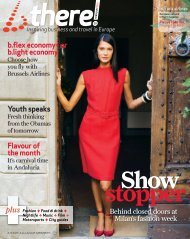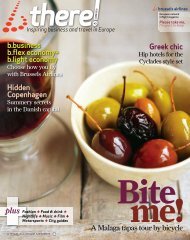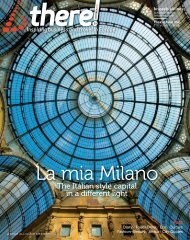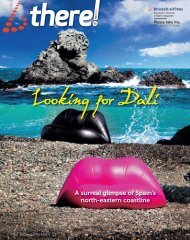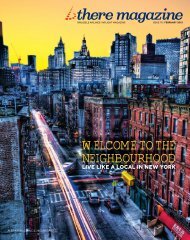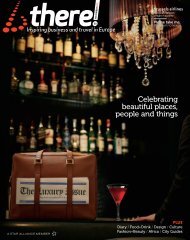You also want an ePaper? Increase the reach of your titles
YUMPU automatically turns print PDFs into web optimized ePapers that Google loves.
IMAGE REX FEATURES<br />
///BUSINESS<br />
Businesstrends<br />
White elephant?<br />
Bugatti’s porcelain motor smashes records for extravagance<br />
Deep-pocketed visitors to next month’s Frankfurt Motor Show might be interested in the<br />
latest headline-hogger from Bugatti – a €1.65m special edition of the Veyron Grand Sport,<br />
partly made out of porcelain. The L’Or Blanc is a joint effort between Bugatti’s parent<br />
Volkswagen and KPM, a 250-year-old Berlin-based porcelain maker. “It may sound like a<br />
pretty odd idea for the world’s fastest convertible car,” said Stefan Brungs, the brand’s sales<br />
chief, with typical Germanic understatement, at the recent unveiling of the car in Berlin. “But<br />
Bugatti has made a name for itself by not shying away from extravagant ideas.” Painted white<br />
with royal blue lines, the L’Or Blanc was, inevitably, developed for an unidentified businessman<br />
from the UAE, who has a collection of about 800 cars. The vehicle features 12 porcelain<br />
elements, including wheel badges and fuel and oil caps.<br />
VW acquired Bugatti in 1998, along with Lamborghini and Bentley, to compete with BMW’s<br />
Rolls-Royce. Having built up publicity over the last few years, Bugatti – which makes around<br />
50 sports cars a year in France – is believed to have got the green light from VW to build a<br />
four-door model, the Galibier. With a 1,000-horsepower engine, this may cost a mere €1m.<br />
Friendly invasion<br />
Russian entrepreneurs flock to Czech capital<br />
Twenty years after Soviet troops slunk out the city, Russian businesses are booming in<br />
Prague. But while the Czech capital seems to be taking this in n its stride, Russia is concerned<br />
at the economic impact of middle-class emigration to Eastern n Europe. In the<br />
first five months of <strong>2011</strong>, net capital outflow from Russia nudged dged €25bn,<br />
which, according to opposition leader Mikhail Kasyanov (right), t), the<br />
government admits is due to dire domestic investment. A recent ent<br />
conference in Prague on the fall of communism heard that while hile Russian<br />
billionaires head for London and New York, a large chunk of money is<br />
staying in the Czech Republic as Russian entrepreneurs launch ch start-ups.<br />
As a result, Russian schools and communities are flourishing ng in and<br />
around Prague; officially, more than 30,000 Russians have residency sidency<br />
permits, while true figures are thought to be much higher. Although though most<br />
Czech citizens seem at ease with this, they’re not turning their ir backs<br />
on their buddies in the West. Last month president Václav Klaus aus<br />
confirmed that the Prague street of the US ambassador’s<br />
residence will be renamed after US president Ronald Reagan, n,<br />
to recognise his contribution to the fall of communism.<br />
50 Brussels Airlines b.there! magazine August <strong>2011</strong><br />
Handle with care: the<br />
porcelain L’Or Blanc<br />
Power to the pedal<br />
Dominance of Copenhagen’s cyclists<br />
angers pedestrians and motorists<br />
With 37% of the population riding their<br />
bicycles to work/school every day – and<br />
50% expected by 2015 – Copenhagen is on<br />
course to be a CO2-neutral capital. Recently,<br />
however, there have been murmurings that<br />
the city’s cyclists have become too powerful,<br />
and the plan for a bike (and pedestrian) bridge<br />
to connect Nyhavn harbour to Christianshavn<br />
island by 2013 has brought things to a head.<br />
Pedestrians complain that bikes are faster<br />
than they were a few years ago, and that<br />
a generation of cyclists now believes it has<br />
right of way throughout the Danish capital.<br />
Motorists, meanwhile, are fuming that<br />
the number of parking permits exceeds the<br />
Are bikes becoming<br />
a menace in the<br />
Danish capital?<br />
number of legal parking spaces in many parts<br />
of Copenhagen, as the city pressures people<br />
to use a bike or public transport instead of<br />
a car. Moreover, in 2010 the price of parking<br />
permits rocketed from DKK 195 (€26) to<br />
DKK 690 (€92). Things have become so<br />
serious that mayor Frank Jensen issued a<br />
press release stating that while Copenhagen<br />
heavily promotes public transport and cycling,<br />
there is also a need to improve conditions<br />
for the city’s drivers. This is being kicked off<br />
with the creation of 1,726 subsidised parking<br />
spaces, mostly earmarked for residents, at<br />
a cost of DKK 161m (€21.6m).<br />
IMAGE GETTY IMAGES



